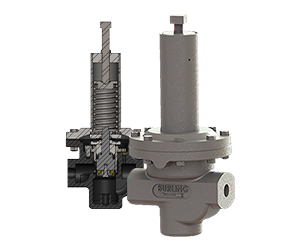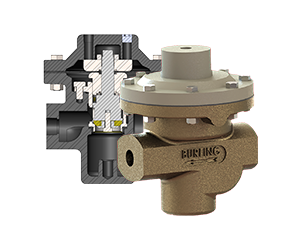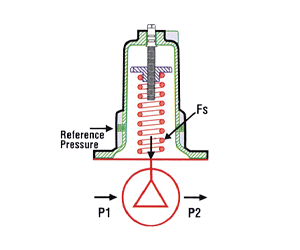Back Pressure Regulators
Back pressure regulators are designed to control upstream (P1) pressure by relieving all pressure above a set pressure from the process being controlled. The Burling Valve regulators can be configured to control the pressure of various gases and liquids accurately and repeatably. Ranging in sizes from 1/2″ up to 6″ flange mount, Burling Valve back pressure regulators are available in dome-loaded or spring-loaded models.

Direct-Acting Back Pressure Regulators
Spring-loaded back pressure valves for industrial applicationsLearn MoreFrequently Asked Questions
A backpressure regulator is a pressure regulator with only an exhaust function. It is designed to regulate pressure in a process that most often either has an alternate pressure source or the process itself causes a pressure increase. A backpressure operates by relieving media from the system when the actual pressure exceeds the setpoint.
Sizing depends on the flow requirements, the desired set pressure, and the characteristics of the fluid (like viscosity). Calculations should consider maximum and minimum flow rates, pressure, and temperature. For further sizing information, please contact us for assistance!
*Reading manufacturer’s manual is suggested for specific instructions*
A backpressure regulator is still a manual regulator with essentially the same mechanical components as a regular pressure regulator. The maintenance requirements are similar.
Common issues like fluctuations in pressure, leaks, or blockages are often troubleshooted by checking for debris in the valve, ensuring the regulator is properly sized, and verifying that the set pressure is appropriate for the system. If none of the above work, your regulator may be malfunctioning.
While versatile, they must be chosen based on compatibility with the specific fluid in terms of material, pressure, and temperature ratings to ensure proper operation and safety. Checking manufacturer specs is highly recommended.
While both act to relieve pressure, back pressure regulators maintain a set pressure by modulating the valve. A relief valve fully opens when the pressure reaches its setpoint. A relief valve has four specifications. Flow rate; accumulation, the maximum pressure above the relief valve setpoint that results in the relief valve fully opening; blowdown, the amount of pressure reduction before the relief valve reseats. The relief valve only relieves when its setpoint is reached and self resets after the pressure reduction. An unregulated pressure reduction occurs when a relief valve operates.
- Precise pressure control: By maintaining a constant outlet pressure, back pressure regulators ensure that processes run consistently, reducing variability and improving product quality.
- Equipment protection: By preventing overpressure conditions, they protect downstream equipment from damage, reducing downtime and maintenance costs.
- Process optimization: They help in stabilizing the flow rate and pressure in a system, leading to more efficient operation and better control over the process.
Similar to a pressure reducing regulator, the backpressure regulator setpoint can be from a mechanical spring or electronic pilot.


